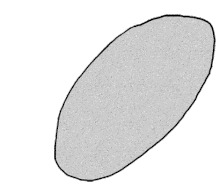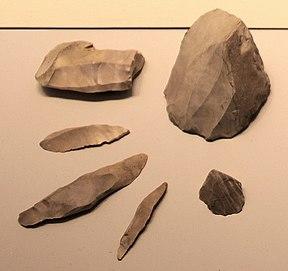The prepared-core technique is means of producing stone tools by first preparing common stone cores into shapes that lend themselves to knapping off flakes that closely resemble the desired tool and require only minor touch-ups to be usable.
In contrast to the production of core tools like handaxes, where cores themselves were the end product shaped and trimmed down by removal of flakes, in prepared-core technique large flakes are the product and the core is used to produce them. This shift made it faster and more resource-efficient, as multiple tools could be struck from a single piece of starting material.[1]
Prepared core preparation techniques are grouped under the label Mode 3 technology.[2] The most well-known prepared core reduction method is the Levallois technique[3]
Prepared core technology was likely invented independently multiple times at different locations.[4] The regular use of Prepared core technology is associated with large-brained hominins such as ''Homo heidelbergensis'', Neanderthals and modern humans. Its widespread use is the defining characteristic of the Middle Stone Age period in Africa and the Middle Palaeolithic (~300.000 - 40.000 years ago) in Europe.[5]
References
- ^ "Middle Paleolithic Tool Technologies". University of California Santa Barbara, Department of Anthropology. Retrieved 16 September 2017.
- ^ "Mode 3 Technologies and the Evolution of Modern Humans". Cambridge Archaeological Journal. Retrieved 30 October 2020.
- ^ "Levallois technique". Oxford University Press. Retrieved 30 October 2020.
- ^ "Early Levallois technology and the Lower to Middle Paleolithic transition in the Southern Caucasus". Science Magazine. Retrieved 30 October 2020.
- ^ "Mode 3 Technologies and the Evolution of Modern Humans". Cambridge Archaeological Journal. Retrieved 30 October 2020.
Bibliography
- Bringmans, P.M.M.A., Vermeersch, P.M., Gullentops, F., Groenendijk, A.J., Meijs, E.P.M., de Warrimont, J.-P. & Cordy, J.-M. 2003. Preliminary Excavation Report on the Middle Palaeolithic Valley Settlements at Veldwezelt-Hezerwater (prov. of Limburg). Archeologie in Vlaanderen - Archaeology in Flanders 1999/2000 VII: 9-30.
- Bringmans, P.M.M.A., Vermeersch, P.M., Groenendijk, A.J., Meijs, E.P.M., de Warrimont, J.-P. & Gullentops, F. 2004. The Late Saalian Middle Palaeolithic "Lower-Sites" at Veldwezelt-Hezerwater (Limburg - Belgium). In: Le Secrétariat du Congrès (eds), Acts of the XIVth UISPP Congress, University of Liège, Belgium. September 2-8, 2001. Section 5: The Middle Palaeolithic. Oxford. British Archaeological Reports (BAR) International Series 1239: 187-195.

.jpg)
